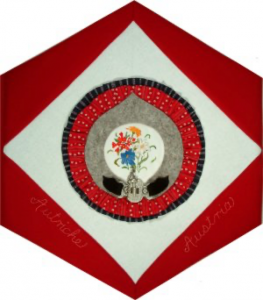Austria

The Block
Embroidered by Lydia Glover, a bouquet of flowers including yellow Arnica, red Alpine Rose, blue Enzian and the well-known white Edelweiss fill the centre of this block. Although these native Austrian alpine flowers are now protected, tradition says that young men should pick Edelweiss as a sign of love for their sweethearts. Handmade grey felt, the fabric used to make hats and vests for the national costume, surrounds the blooms. Red and blue material layered around the felt is finely pleated to recall the distinctive dirndl, the working dress of female servants now worn by many women as an Austrian costume for formal occasions and during traditional events such as Oktoberfest. The pewter clasp that embellishes the square represents the buckles and buttons that typically decorate Austrian aprons, vests, and jackets.
Cultural Profile
Austria, a small mountainous country in the heart of Europe, is a land of both natural and cultural beauty. Thanks to its central position on the continent, the country has long been a meeting place of various European cultures. Vienna, famous for its lavish coffee houses, opulent architecture and vibrant culture, has continuously ranked as one of the best cities in the world to live in. The official language is standard German, although English is understood and spoken by many.
The birthplace of composers such as Mozart, Haydn, Liszt, Schubert or Strauss, Austria is known for its music and dance, as evidenced by the many lavish balls and festivals celebrated throughout the year. Indeed, the contribution of the country to Western culture is staggering: Austrians have had a durable impact on philosophy, architecture, sciences, cinema and literature.
Austrian artisans are renowned for their wood carvings and hand-carved chests displaying hand-painted flowers. Textile arts include lace making, and strong trade relations exist between the Austrian lace makers and Nigeria, where the lace is exported and very popular. The traditional lederhosen worn by men as part of the tracht, the traditional dress, are examples of Austrian leatherwork. Glasswork also has a long tradition in Austria due to the proximity to Bohemia, and the country is home to many exquisite stained glass windows. Today, glassware factories everywhere in the country still keep those traditions alive. Porcelain pieces from Augarten and Gmundner are also sought-after items.
Records indicate there are now over 197,000 people of Austrian descent living in Canada, primarily in Ontario and Alberta. They have adapted quickly, both culturally and economically, to the Canadian way of life. Austrian organizations, including the Austrian Canadian Society, exist in many major cities across the country and through these, Austrians joyfully maintain their rich cultural heritage and share it with other Canadians.
Sponsor: Austrian-Canadian Council
